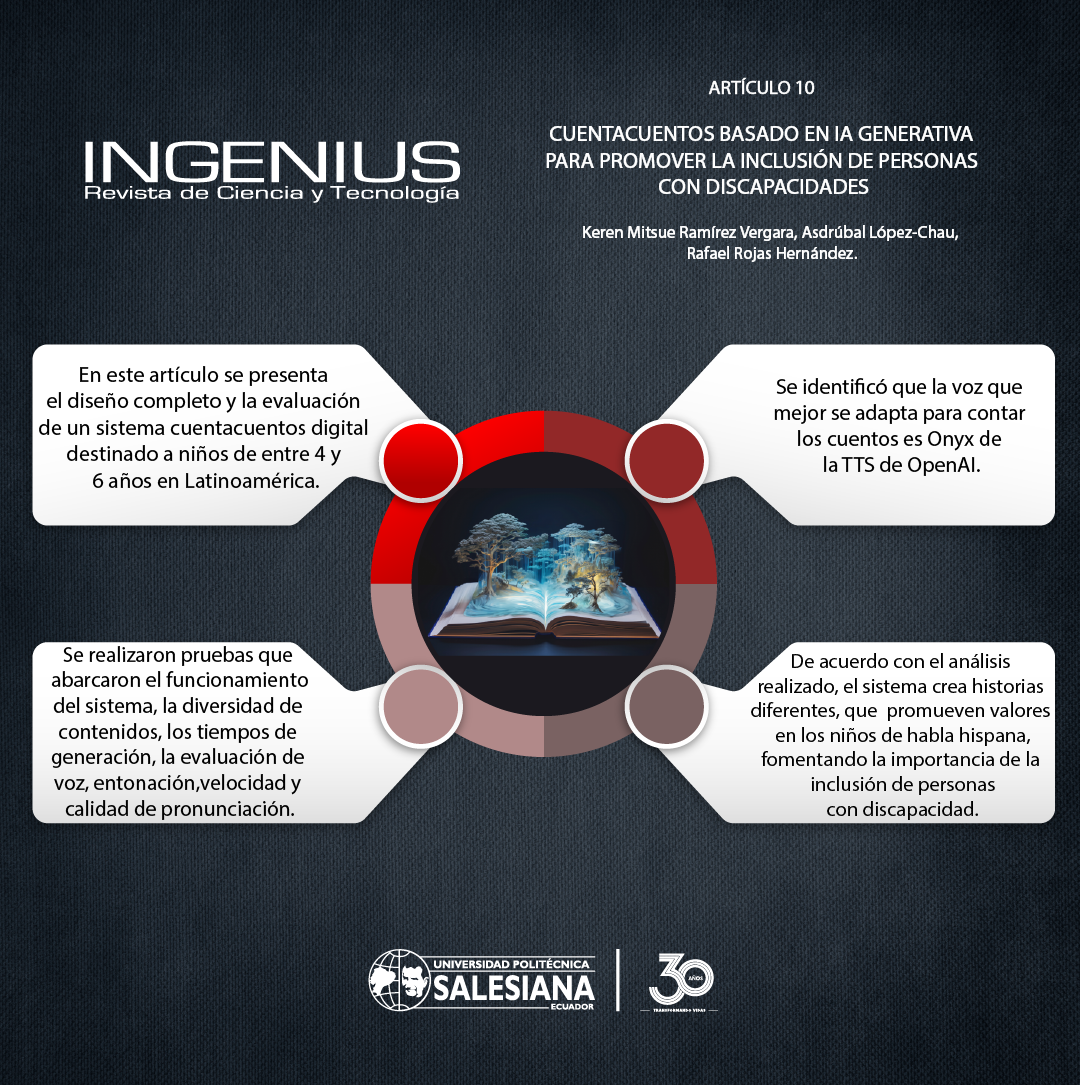Storytelling based on generative AI to promote the inclusion of people with disabilities
Main Article Content
Abstract
Article Details

This work is licensed under a Creative Commons Attribution-NonCommercial-ShareAlike 4.0 International License.
The Universidad Politécnica Salesiana of Ecuador preserves the copyrights of the published works and will favor the reuse of the works. The works are published in the electronic edition of the journal under a Creative Commons Attribution/Noncommercial-No Derivative Works 4.0 Ecuador license: they can be copied, used, disseminated, transmitted and publicly displayed.
The undersigned author partially transfers the copyrights of this work to the Universidad Politécnica Salesiana of Ecuador for printed editions.
It is also stated that they have respected the ethical principles of research and are free from any conflict of interest. The author(s) certify that this work has not been published, nor is it under consideration for publication in any other journal or editorial work.
The author (s) are responsible for their content and have contributed to the conception, design and completion of the work, analysis and interpretation of data, and to have participated in the writing of the text and its revisions, as well as in the approval of the version which is finally referred to as an attachment.
References
J. R. Casar Corredera, “Inteligencia artificial generativa,” Anales de la Real academia de Doctores, vol. 8, no. 3, pp. 475–489, 2023. [Online]. Available: https://is.gd/3kMGMX
J. Sanabria-Navarro, Y. Silveira-Pérez, D. Pérez-Bravo, and M. de Jesús-Cortina-Núñez, “Incidences of artificial intelligence in contemporary education,” Comunicar, vol. 77, pp. 97–107, 2023. [Online]. Available: https://doi.org/10.3916/C77-2023-08
S. Droubi, A. Galamba, F. L. Fernandes, A. A. de Mendonça, and R. J. Heffron, “Transforming education for the just transition,” Energy Research & Social Science, vol. 100, p. 103090, 2023. [Online]. Available: https://doi.org/10.1016/j.erss.2023.103090
S. Iruri Quispillo and C. A. Villafuerte Alvarez, “Importancia de la narración de cuentos en la educación,” Comuni@cción: Revista de Investigación en Comunicación y Desarrollo, vol. 13, no. 3, pp. 233–244, Sep. 2022. [Online]. Available: https://doi.org/10.33595/2226-1478.13.3.720
M. Pozas, C. J. G. Trujillo, and V. Letzel-Alt, “Mexican school students’ perceptions of inclusion: A brief report on students’ social inclusion, emotional well-being, and academic self-concept at school,” Frontiers in Education, vol. 8, 2023. [Online]. Available: https://doi.org/10.3389/feduc.2023.1069193
B. Mundial, “Rompiendo barreras - inclusión de las personas con discapacidad en américa latina y el caribe.” [Online]. Available: https://is.gd/diWoks
K. Ramirez. (2023) Cuentacuentos. GitHub, Inc. [Online]. Available: https://is.gd/yHfQvW
T. Bratitsis and P. Ziannas, “From early childhood to special education: Interactive digital storytelling as a coaching approach for fostering social empathy,” Procedia Computer Science, vol. 67, pp. 231–240, 2015, proceedings of the 6th International Conference on Software Development and Technologies for Enhancing Accessibility and Fighting Info-exclusion. [Online]. Available: https://doi.org/10.1016/j.procs.2015.09.267
P. Juppi, “Engagement and empowerment. digital storytelling as a participatory media practice,” Nordicom Review, vol. 39, 12 2017. [Online]. Available: https://is.gd/Wo91Bc
T. Tseng, Y. Murai, N. Freed, D. Gelosi, T. D. Ta, and Y. Kawahara, “Plushpal: Storytelling with interactive plush toys and machine learning,” in Proceedings of the 20th Annual ACM Interaction Design and Children Conference, ser. IDC ’21. New York, NY, USA: Association for Computing Machinery, 2021, pp. 236–245. [Online]. Available: https://doi.org/10.1145/3459990.3460694
J. Haase and P. H. Hanel, “Artificial muses: Generative artificial intelligence chatbots have risen to human-level creativity,” Journal of Creativity, vol. 33, no. 3, p. 100066, 2023. [Online]. Available: https://doi.org/10.1016/j.yjoc.2023.100066
R. Li, “A “dance of storytelling”: Dissonances between substance and style in collaborative storytelling with ai,” Computers and Composition, vol. 71, p. 102825, 2024. [Online]. Available: https://doi.org/10.1016/j.compcom.2024.102825
S. Habib, T. Vogel, X. Anli, and E. Thorne, “How does generative artificial intelligence impact student creativity?” Journal of Creativity, vol. 34, no. 1, p. 100072, 2024. [Online]. Available: https://doi.org/10.1016/j.yjoc.2023.100072
S. Kalantari, E. Rubegni, L. Benton, and A. Vasalou, ““when i’m writing a story, i am really good” exploring the use of digital storytelling technology at home,” International Journal of Child-Computer Interaction, vol. 38, p. 100613, 2023. [Online]. Available: https://doi.org/10.1016/j.ijcci.2023.100613
J. Su and W. Yang, “Artificial intelligence in early childhood education: A scoping review,” Computers and Education: Artificial Intelligence, vol. 3, p. 100049, 2022. [Online]. Available: https://doi.org/10.1016/j.caeai.2022.100049
S. Z. Salas-Pilco, K. Xiao, and J. Oshima, “Artificial intelligence and new technologies in inclusive education for minority students: A systematic review,” Sustainability, vol. 14, no. 20, 2022. [Online]. vailable: https://doi.org/10.3390/su142013572
H. Yu, “The application and challenges of chatgpt in educational transformation: New demands for teachers’ roles,” Heliyon, vol. 10, no. 2, January 2024. [Online]. Available: https://doi.org/10.1016/j.heliyon.2024.e24289
L. Sijing and W. Lan, “Artificial intelligence education ethical problems and solutions,” in 2018 13th International Conference on Computer Science & Education (ICCSE), 2018, pp. 1–5. [Online]. Available: https://doi.org/10.1109/ICCSE.2018.8468773
E. Valverde and P. Hernández, TypeScript, 2023. [Online]. Available: https://is.gd/WICHuR
J. Collell and A. Ferry, CSS3 y Javascript avanzado. Universitat Oberta de Catalunya, 2023. [Online]. Available: https://is.gd/JrhbAi
A. Nazir and Z. Wang, “A comprehensive survey of chatgpt: Advancements, applications, prospects, and challenges,” Meta-Radiology, vol. 1, no. 2, p. 100022, 2023. [Online]. Available: https://doi.org/10.1016/j.metrad.2023.100022
M. Vicente-Yagüe-Jara, O. López-Martínez, V. Navarro-Navarro, and F. Cuéllar-Santiago, “Writing, creativity, and artificial intelligence. chatgpt in the university context,” Comunicar, vol. 77, pp. 47–57, 2023. [Online]. Available: https://doi.org/10.3916/C77-2023-04
J. J. López. ¿cuántas palabra tiene un cuento o relato corto? [Online]. Available: https://www.anecdotario.net/p/palabras-cuento.html?m=1
OpenAI. (2023) Text generation models. OpenAI Platform. [Online]. Available: https://is.gd/fkWCFZ
——. (2023) Text to speech. OpenAI Platform. [Online]. Available: https://is.gd/XskwW5

